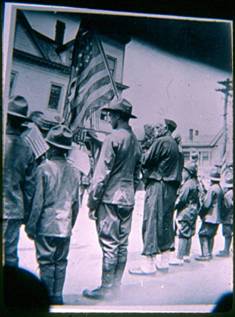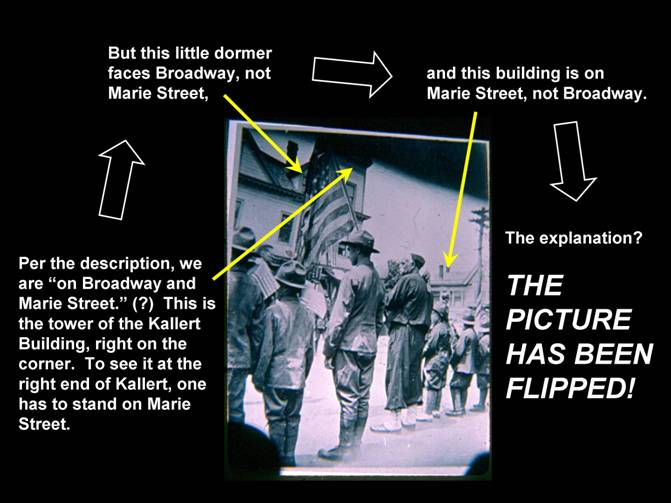Appendix II: The Story of the Photograph
Regular readers of Ancient Hixtory- there may be some - know that I sometimes voice frustration (i.e., rant childishly) about badly-taken and badly-handled old photographs. I am always sincerely grateful that historic images exist in any form, but I hate to find an old picture that may be one-of-a-kind, and realize that it could have been much better, and could have communicated better, had someone only given a little more thought to taking or preserving it. My rant this time is complicated; I'll do my best.
When we look at the image we see online (below, left) we're obviously looking at a picture, likely a transparency, taken in a darkened room during a lecture of some sort. The subject of this picture is an image projected on a screen, which appears distorted because of the angle of the screen relative to the camera used. The blue fringes around the silhouetted heads in the foreground tell us two things: color film was used, and the film and lens could not handle the extremes of the lighting very well. Hence, the lecturer's slide was more detailed and clear than what we see.

"Raw" Online Image

Geometrically Corrected Image

If we had the name of the lecturer, or knew where the lecture was given, we might be able to track down the lecturer's slide, and perhaps even the source from which it was made, and thus be able to learn more from a higher-quality image. Alas, the only metadata about the image available at HPL Historic Photographs at nyheritage.org is the description you see shown with it above - a description which ignores the man in the Zouave uniform!
*
I made corrections to the image as found. I restored its color state to monochrome. I rectified the tilt. I improved the distorted perspective geometry, which was introduced by the angle from which the last slide was made. I "removed" the distracting foreground heads. And finally, I flipped the image horizontally, because it already had been reversed in error. How do I know this?
In 1919, the Kallert Building (below) stood on the southeast corner of Broadway and Marie Street. It had been repainted and remodeled over the years, but its square tower with overhanging roof remained distinctive.

Kallert Building, extracted from an image found on
longislandgenealogy.com/PCsMThomas/ImagesOfOldLI.html

Our picture shows the Kallert across the street from where the photographer was, but as noted in the above diagram, things look wrong. A look at other sources of local historic images, including one created by fellow HHS graduate Mark Thomas, gives us the clue that explains things. When looking at the small dormer in the Kallert, we see it the right of the corner tower, but in the online image, it is partially visible (along the upper edge of the flag) to the left of the tower. The only possibility is that image has been flipped over. Unflipping it shows that the photographer was standing on Broadway, and the distant buildings were on Marie Street (a fact that is easily confirmed by looking at other historic photographs).
Most likely, the image was donated to the Library as a slide, and the slide was flipped over at some point, and scanned as a mirror image of itself. To resume my rant for a moment... to make such an error, and not double check, when producing something for public viewing is inexcusable. It is easy to verify which side of a slide is front and which is back. Oh well.
*
The text on NYHeritage notes that "The boys [are] wearing Doughboy uniforms...." This is unlikely, although children's Army uniforms were indeed sold during the war. It is more likely that the children are Boy Scouts, who were out for the parade, and who in that era dressed in vaguely similar uniforms. I suggest that the adult among them was wearing a Scoutmaster uniform; an adult civilian would not have dared to wear a fake doughboy uniform in the presence of real soldiers. A tell-tale difference from soldiers' uniforms is the lack of epaulettes. Another is that the boys are wearing gaiters over their lower legs, whereas - like my father's brother Gus in this wartime photograph - real doughboys wore wrap-around puttees:

Ron's Uncle Gus, c.1918
Collection of Ronald A. Wencer
*
As to the identity of our flag-holding Zouave, and the coloring I added. From records, it appears that at least two men who later lived in Hicksville had served in regiments which used such uniforms at the time that their regiments entered the Civil War. I phrase it in that awkward way because some Zouave regiments quickly switched to more easily maintainable (and less visible) "regular" uniforms once they saw combat.
However, by May 1919, all of Hicksville's Civil War veterans had died, except for Louis Meyer and Henry Menge (about whom I wrote last month), and I do not believe that either of them had belonged to Zouave regiments. I can imagine Menge's donning such a uniform whimsically, because there was a Brooklyn regiment - not the one in which he served, but another with the same number! - that did wear Zouave uniforms. I believe, however, based on the only other photo I have seen of Henry Menge, that he is not the man in this picture.
Enter a mystery veteran. The Long-Islander separately reported on another public event which occurred roughly around this time, at which a Bethpage resident turned up, wearing his old Zouave uniform, and bearing a torn and well-worn flag. He may well be the man we see above. Unfortunately, his name must have been reported incorrectly; I have yet to find any record of him.
For this article, I tinted the uniform match to those of several Pennsylvania and New York regiments, all of which used the same basic colors. Photographs and paintings show that their Zouave hats were inconsistent in shape, even within a single regiment, although they generally were consistent in color. Hats which featured trailing gold-colored tassels (often made of yarn) sometimes had bands of white fur (probably rabbit) around the head opening, and/or a furry white band further up the hat.
***

